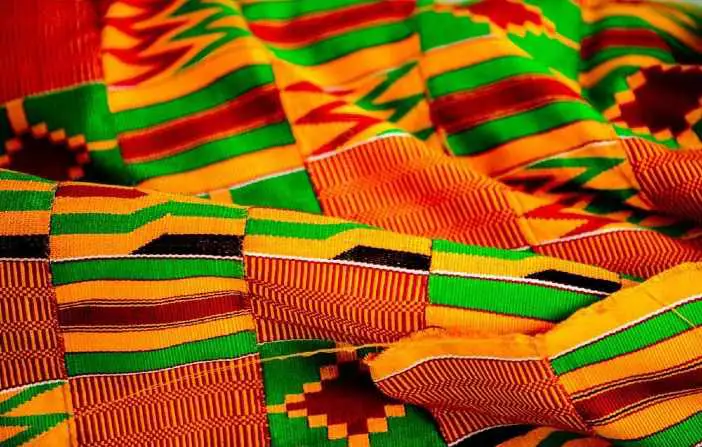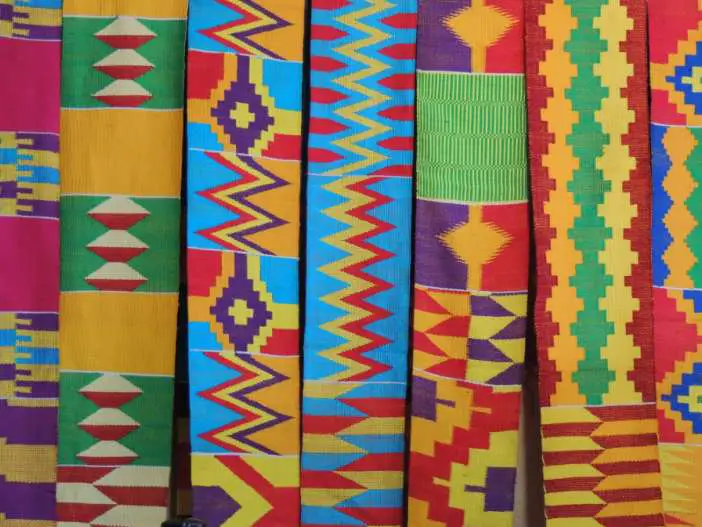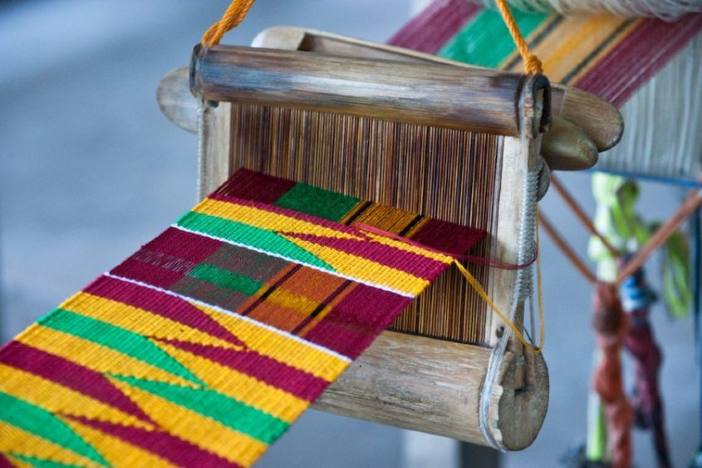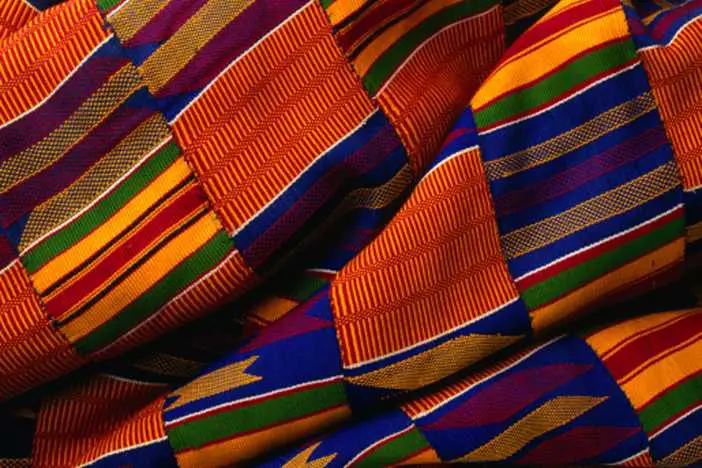No doubt African prints have unique meaning and origin stories tied to them. This is why they have more resonance now because of the backlog of history behind it. African Kente fabric is a cloth that has sacred meaning and representation that has been passed down from weaver to weaver over generations.
There is a lot to know about Kente when it comes to representation and the meaning it carries. Kente cloth originated from the deep culture of the Ashanti/Akan people (now in Ghana). It originated hundreds of years ago.
Then it moved to the more modern meaning of representing the struggles of Africans in the diaspora. Kente is a cloth that stands out among other African pieces as more than just a fashion piece.
There are reasons why the fabric is seen as sacred. In early cultures in West Africa where it originated from, you can’t wear Kente without meaning. There is a deep meaning attached to it. This is what makes the fabric unique.
Reasons Why Kente is Sacred

When something is seen as sacred, it means it is not to be looked at with linear interpretation. There are connotations behind it, making it bear the weight it does. There are reasons why Kente is seen as sacred, and it stems right from its root in history, myths, and legends.
1. It represents royalty
Centuries ago, Kente was a cloth reserved for royals and elites in the Akan community. Also, it was worn on only special occasions. The Akan royalty was known to have adopted the fabric as a symbol to show their royal standing because of its colors and intrinsic patterns.
Kente weaving in Africa is still seen as a royal duty, where colors and patterns with specific meanings or names are created to represent the wearer.
2. The colors have specific meaning
The colors of Kente fabrics have symbolic meaning. In the Akan culture, these colors are an expression of life, spiritual, philosophical, gender, and many more.
For instance, white signifies purity, spirituality, innocence, and peace. Yellow or gold is a color of royalty, wealth, and fertility. Also, the color is always strongly expressed in Kente. Blue is a reminder of the sky, peacefulness, wisdom, humility, and communion.
Black represents mourning, darkness, loss, secrecy, and mystery. While healing means cleansing and healing. Brown is a representation of the mother earth, and green a symbol of growth, life, and harmony.
Red, mostly worn by men expressed politics. And feminine colors like pink and purple colors expressed tenderness, sweetness, female essence of life, and calmness.
3. The shapes were symbolic to life
Naturally, if the colors have meanings, the shapes and patterns of the Kente cloth will also too. The colors are what gives patterns a deeper meaning.
There are generally five shapes common to Kente. These shapes are the most common patterns woven to a Kente. They include square, diamond, triangle, circle, and cross.
The square shape symbolizes the cosmos and earth. It is usually associated with life and procreation. This is why you would find it in feminine colors like pink and purple. Also, the shape is a representation of the matrilineal line of the Akan culture.
The three lines of the triangle shape symbolize family, life, and birth. The baseline being represented as birth. It means the realization of one’s existence or purpose in life. And the summit of the triangle means death.
After achieving all you can, you pass on. The triangle is the representation of the completeness of a man’s lifecycle.
Diamond is the representation of man as a king. The two contrasting triangles mean both his role as king and man are intertwined. Also, it means a king’s duty should be for the preservation of the culture’s prestige.
And the cross shape symbolizes two elements; water and fire. Representing breath of life, force, and existential landmark. Meanwhile, the circle symbolizes infinity or abundance. It represents something that has neither a beginning nor an ending. It is used to describe the universe and the life of people in a community.

4. The patterns have names
What makes the Kente sacred is the names given to them by the weavers. Traditionally, a weaver gives the pattern of his Kente fabric a name. It could be tied to a person, a folktale, a proverb, elegy, philosophy, values, behavior, or an event. Also, naming a Kente fabric was seen as a way of communion with the spirit world.
The weaver creates the Kente by inspiration and calls it a befitting name for it. This is just like how an artist names his art. When the Kente is commissioned, the chiefs or elders may also give the Kente a name.
This act made the fabric more sacred to people, especially to those whose Kente had a meaning mirroring their life. A Kente with a good name was said to bring good fortune to the wearer.
5. It represents black activism
This is a more modern shift away from West African beliefs. Kente became popular in America after the first Ghanaian Prime Minister, Kwame Nkrumah, wore the fabric to meet President Eisenhower at the white house.
Then in the 1970s, the fabric was predominantly used to connote black politics and activism. The cloth along with Dashiki was worn in solidarity with the African American struggle and to show pride in African heritage. Also, Africans in the diaspora used it to show solidarity to their motherland.
However, the importance of Kente cloth wanes in the 1980s. But became popular again among African American and African students who were able to graduate from college. The Kente stole is worn to signify crossing a hurdle that would have been difficult to jump.
Kente FAQs

What is Kente?
Kente is a fabric made of silk, cotton, or rayon fabrics and then it is interwoven strips. It is a native cloth of the Akan/Asante and Ewa cultures in Ghana. Most traditional Kentes are handwoven and are made into intricate patterns with a colorful array of cloth strips.
The higher the quality of the fabric used to make Kente, the more selected it is. The good quality Kente cloths are mostly reserved for royals and high class in the society.
Kente means woven cloth in different languages. The Akan language calls it nwentoma meaning ‘woven cloth’. The Ewa culture (now northern Ghana) called the fabric kete, also meaning woven fabric. But in the Twi language, the word means ‘basket’ which is a description of the designs woven together.
What is the story behind Kente?

There are different stories in different times in history related to the origin of Kente. The folklore behind the fabric starts with a fable.
According to Asante mythology, the great trickster Ananse the Spider spun an intricate web in great detail and shape in the jungle. Two weaver brothers, Nana Ameyaw and Nana Kuragu learned these web designs. The outcome of the design is Kente.
Then we have historical documentation that highlights the textile becoming more popular as early as 1000 B. C. among the Akan and Ewe people. The cloth expanded beyond its community when trade routes with surrounding communities were established.
But the richly colored fabric did not become a symbol of royalty until the 17th century. Then the Kente fabric became a royal attire in the growing Asante Empire. It was worn by people of royalty and nobel class. The men wore it like a toga wrapped around their bodies, and the women wore it as a two-piece wrapper.
Then with social changes over time, Kente became a national cloth for the country Ghana. It is worn for special occasions like weddings. However, the tradition of not cutting the cloth has been moved aside. Now it favors new modern styles and designs that are not restricted to the local culture anymore.
Who can wear a Kente stole?

Kente stoles can be worn by graduating students from high schools, colleges, and universities. The practice became popular among graduate students in the 90s.
Back then in 1993, four people from West Chester University, Pennsylvania. Dr. Franklin Simpson, Jerome Hutson, Drs. Christian Awuyah and C. James Trotman started the Kente Commencement Ceremony to honor black people who were able to complete their baccalaureate.
Over time, other universities partook in wearing Kente stoles especially by people of African descent in the diaspora with their African heritage.
Black students wore Kente stoles to show successful completion of a struggle that was difficult. They also wore it to represent the sorority, fraternity, or groups they were affiliated to while in school.
The practice is very prevalent among African American students graduating high school or college. However, wearing Kente stoles for graduation is being practiced by students of other ethnic groups. Anyone who wishes to can participate in the Kente stole graduation celebration.
Read Also: 6 Ways You Can Wear African Kaftan
Conclusion
When it comes to African fabrics, they hold meaning that is beyond cultural, historical, or mythological beliefs. That is why a traditional fabric like Kente is sacred.
Over the course of history, the cloth has meaning and symbolism that shows the richness of the West African culture it originated from. Centuries ago, it was worn by royalty and elites of the Asante tribe (now in Ghana), then it became a symbolic national cloth for Ghana.
The fabric spread its wings in America during the African American struggles in the 70s. And now is a known stole to be worn by students during graduation to signify their triumph in crossing a hurdle.
There is no doubt when someone asks is Kente sacred. This is because the answer is as clear as day. It is.
Africana fashion caters to your curious lifestyle and fashion questions by providing you with relevant fashion articles.







